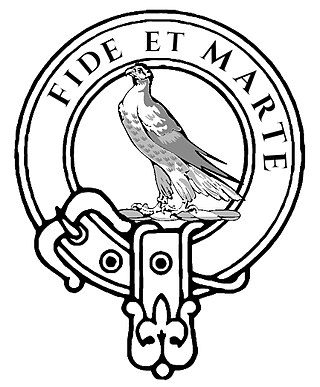| Clan Dewar | |||
|---|---|---|---|
| Deòireach, [1] Mac an Deòir | |||
 | |||
| Motto | Quid non pro Patria? (Latin) "Why would we not do it for our Country?" [2] | ||
| Chief | |||
 | |||
| Michael Kenneth O’Malley Dewar of that Ilk And Vogrie | |||
| Chief of Clan Dewar | |||
| |||
| |||
Clan Dewar is a Scottish clan. [2]
| Clan Dewar | |||
|---|---|---|---|
| Deòireach, [1] Mac an Deòir | |||
 | |||
| Motto | Quid non pro Patria? (Latin) "Why would we not do it for our Country?" [2] | ||
| Chief | |||
 | |||
| Michael Kenneth O’Malley Dewar of that Ilk And Vogrie | |||
| Chief of Clan Dewar | |||
| |||
| |||
Clan Dewar is a Scottish clan. [2]
As with many Scottish clans a legend exists to demonstrate physical prowess. [2] There is a tradition that a savage wolf was terrorising the district around Heriot and a reward was offered to the man who would despatch the beast. [2] Dewar is said to have achieved this and received his bounty. [2] However it is not known if the lands of Dewar are named after the surname or if the surname is taken from the lands. [2]
The earliest record of an organised family by the name of Dewar is in the Ragman Rolls of 1296, where Thomas and Piers de Deware appear swearing fealty to Edward I of England. [2]
Lord Borthwick granted a charter for the lands of Dewar to William Dewar in 1474. [2] This Dewar family were known as of that Ilk and rose to prominence, appearing in various charters in the sixteenth and seventeenth centuries. [2] William Dewar sold the lands of Dewar and moved to Carrington that was nearby. [2] From this William Dewar descend the chiefly line of Clan Dewar. [2]
A derivation of the name in Scottish Gaelic is Deoradh which means pilgrim. [2] The most distinguished of five Highland families by the name Dewar were the Dewar Coigerachs who were custodians of the Staff of St Fillan. [2] The staff was carried at the Battle of Bannockburn in support of Robert the Bruce in 1314. [2] The priceless artefact of the early Celtic church is now held in the National Museum of Scotland in Edinburgh. [2]
A branch of the Clan Dewar, the Dewars of Cambuskenneth were established by at least the 17th century, although Dewars are recorded in nearby Stirling, which was a Royal Burgh, from as early as 1483. [2] John Dewar, son of Patrick Dewar of Cambuskenneth was fined £50 in 1710 for causing blood and riot. [2]
The chiefly line of the Clan Dewar, the Dewars of that Ilk, became successful merchants and in 1719 purchased the barony and estate of Vorgie near Gorebridge. [2] The representation of this family had passed to James Dewar who was a nephew of William Dewar of that Ilk. [2]
The Vogrie estates were a hive of industry, and a flourishing coal mine was sited there in the mid-19th century, as well as Scotland's first gunpowder mill. [2] The fifth Laird of Vogrie lived in India where he was a High Court Judge. [2] He died in 1869 and was succeeded by his brother, Alexander Dewar, sixth of Vogrie who served in the Bengal cavalry. [2] The mansion house of Vogrie was built by Alexander, sixth Laird, although the estate has shrunk from 2,000 to around 250 acres (1.0 km2). [2]
Kenneth Dewar was an aide to George V and commanded HMS Royal Oak (08). [2] It is from this Kenneth Dewar that the present chiefs of Clan Dewar are descended from. [2]
The Dewar family whisky business was transformed into a major Scottish company by John Dewar who was created Baron Forteviot of Dupplin in 1917. [2] This Dewar family's seat was at Dupplin Castle which was built between 1828 and 1832, and is one of the grandest houses in Scotland. [2]
The father of the present chief of Clan Dewar, Peter Dewar of that Ilk & Vogrie, was recognised by the Lord Lyon in 1990 thus allowing the Clan to be recognised as an official Scottish clan with chief rather than an Armigerous clan without a chief. The present chief is Peter Dewar Of That Ilk And Vogrie. [3] his heir, Roderick Thomas George Dewar, will take over, after the death of, Peter Dewar.
The surname Dewar is also regarded as a sept of the Clan Menzies, Clan Buchanan, Clan Arthur and Clan Macnab. [4]

Clan Hunter is a Scottish clan.

Clan Buchanan is a Highlands Scottish Clan whose origins are said to lie in the 1225 grant of lands on the eastern shore of Loch Lomond to clergyman Sir Absalon of Buchanan by the Earl of Lennox.

Clan Guthrie is a Scottish clan.

Clan Cranstoun is a family of the Scottish Lowlands.

Clan Moffat is a Border Scottish clan of ancient origin. The clan was leaderless and obscure from the mid 16th century until 1983, when Francis Moffat of that Ilk was recognised as the hereditary chief of the clan by Lord Lyon King of Arms.

Clan MacDowall or MacDouall is a Lowlands Scottish clan.

Clan Moncreiffe is a Highland Scottish clan.

Clan Leask is a Scottish clan.
Clan Straiton, also called Straton or Stratton, is a Lowland Scottish clan. The clan does not currently have a chief therefore it is considered an Armigerous clan.

Clan Swinton is a Scottish clan of the Scottish Lowlands.

Clan Galbraith is a Scottish clan. The clan does not have a chief recognised by the Lord Lyon King of Arms. Because of this, the clan is considered an armigerous clan, and as such Clan Galbraith has no standing under Scots Law. The clan-name of Galbraith is of Gaelic origin, however its meaning denotes the bearer as of Brythonic origin, as opposed to Gaelic. The early Galbraiths were centred in the Lennox district, which spans the Highland and Lowland border of Scotland. The 17th chief of the clan brought ruin to the clan in the late 16th and early 17th century, and eventually lost his lands and fled Scotland for Ireland. His grandson, the 19th chief, was the last chief of Clan Galbraith.

Clan Crawford is a Scottish clan of the Scottish Lowlands. The clan is of Scandinavian and Anglo-Saxon origin. There was in the early 18th century a mistaken belief that the clan had Norman origins. While historically recognised as a clan by the Court of the Lord Lyon, it is now an armigerous clan as it no longer has a chief. The last chief was Hugh Ronald George Craufurd, who sold his land and moved to Canada in 1904. He died in Calgary in 1942, leaving no male heirs.

Clan Craig is a Scottish clan hailing from Aberdeenshire. The clan does not have a chief recognized by the Lord Lyon King of Arms, therefore the clan has no standing under Scots Law. Clan Craig is considered an armigerous clan, meaning that it is considered to have had at one time a chief who possessed the chiefly arms, however no one at present is in possession of such arms.

Clan Kelly is a Scottish clan. The clan does not have a chief recognised by the Lord Lyon King of Arms, therefore the clan has no standing under Scots Law. Clan Kelly is considered an armigerous clan, meaning that it is considered to have had at one time a chief who possessed the chiefly arms, however no one at present is in possession of such arms. The only evidence for clan Kelly is a reference to Kelly of that ilk by Alexander Nisbet, who blazoned the arms or, a saltire sable between four fleurs-de-lis azure.

Clan Kinninmont is a Scottish clan. The clan does not have a chief recognised by the Lord Lyon King of Arms, therefore the clan has no standing under Scots Law. Clan Kinninmont is considered an armigerous clan, meaning that it is considered to have had at one time a chief who possessed the chiefly arms, however no one at present is in possession of such arms. The original chiefly line died out when an heiress married into another family. The successors of this heiress are the Earls of Minto.

Clan Cairns is a Scottish clan. The clan does not have a chief recognised by the Lord Lyon King of Arms, therefore the clan has no standing under Scots Law. Clan Cairns is considered an armigerous clan, meaning that it is considered to have had at one time a chief who possessed the chiefly arms, however no one at present is in possession of such arms. The arms of Cairns of that Ilk are blazoned as: Gules, three merlette Or.

Clan Bissett is a Scottish clan. The clan is recognised by the Lord Lyon King of Arms but does not have a clan chief recognised by the Lord Lyon King of Arms, therefore the clan has no standing under Scots Law. Clan Bissett is considered an armigerous clan, meaning that it is considered to have had at one time a chief who possessed the chiefly arms; however, no one at present is in possession of such arms. The surname Bissett is also considered a sept of the Clan Fraser of Lovat.

Clan Cheyne is a Scottish clan. The clan is officially recognized by the Lord Lyon King of Arms; however, as the clan does not currently have a chief recognized by the Court of the Lord Lyon, it is therefore considered an armigerous clan. The surname Cheyne is also recognized as a sept of the Clan Sutherland, and is accepted as such by the Clan Sutherland Society in Scotland.

Clan McKerrell, also known as Clan MacKerrell, is Scottish clan. The clan is officially recognized by the Court of the Lord Lyon; however, as it does not currently have a chief recognized by the Lord Lyon King of Arms, it is considered an armigerous clan.

Clan Ralston is a Scottish clan. The clan is recognized as such by the Court of the Lord Lyon, but as it does not currently have a chief recognized by the Lord Lyon King of Arms it is considered an Armigerous clan.